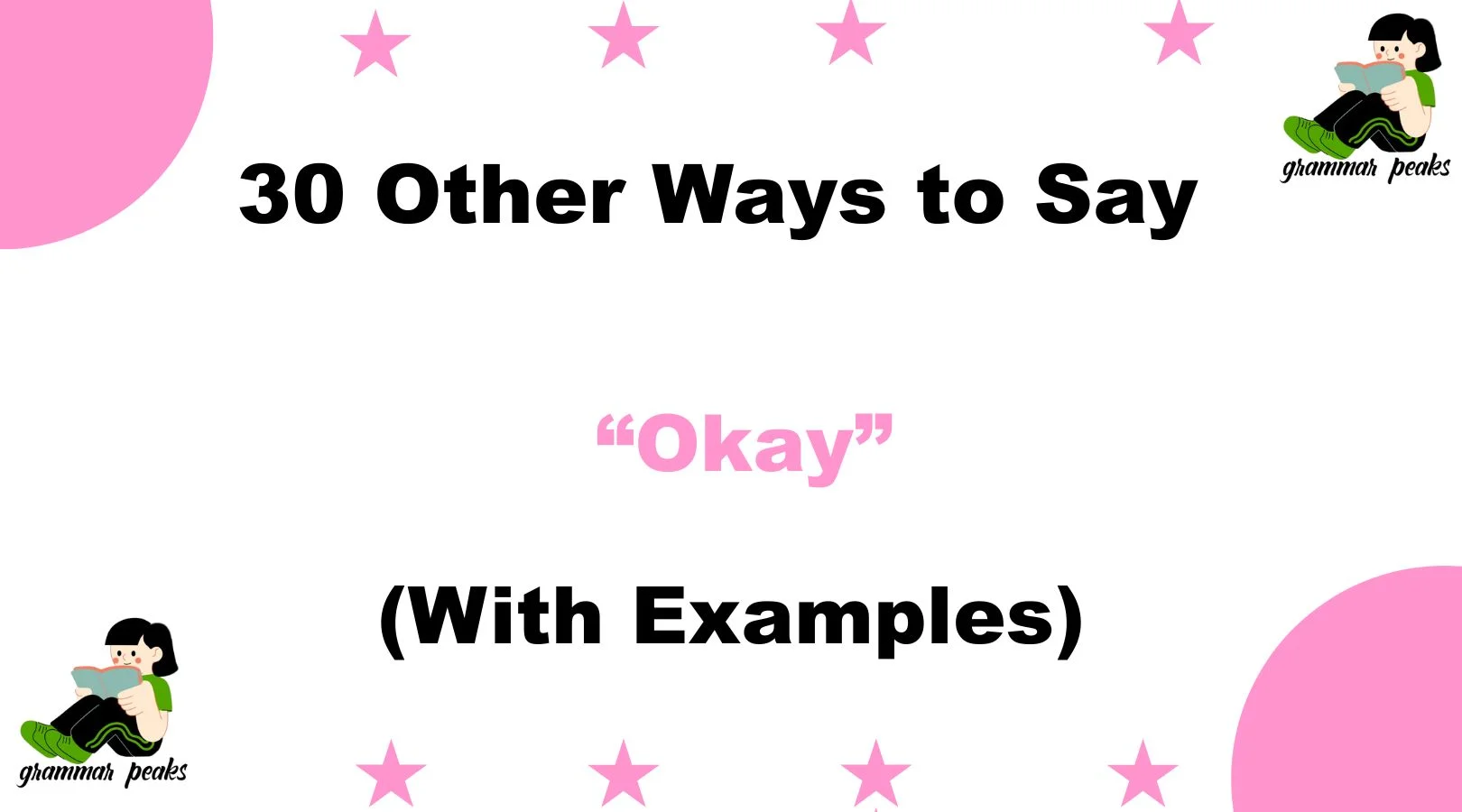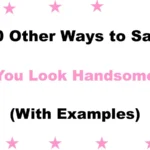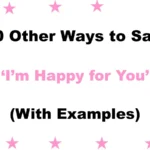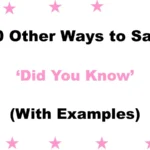Whether you’re responding to a request, acknowledging information, or giving approval, saying “okay” can sometimes feel repetitive, vague, or too casual—especially in professional or nuanced conversations. That’s why having a variety of alternatives helps you communicate more clearly and intentionally. This guide explores 30 different Other Ways to Say “Okay” depending on tone, context, and relationship—so you can sound more thoughtful, professional, or warm when needed.
What Does “Okay” Mean?
“Okay” is a flexible word used to express agreement, approval, acknowledgement, or acceptance. It can mean “yes,” “understood,” “fine,” or even “I’m indifferent.” Because it’s so broad and informal, people often look for more precise or emotionally intelligent alternatives.
When to Use “Okay”
Use “okay” when:
- You’re casually agreeing to something.
- You want to acknowledge what someone said.
- You need a neutral or minimal response.
- You’re responding quickly or informally.
However, in formal communication, written replies, or sensitive situations, you may want to choose a more specific or polished phrase.
Is It Professional/Polite to Say “Okay”?
Sometimes. In casual communication or among coworkers you know well, “okay” is perfectly acceptable. But in professional emails, meetings, or when tone matters, it can come off as dismissive or lacking engagement. Using alternatives like “Understood” or “Sounds good” can feel more polished and intentional.
Pros and Cons of Saying “Okay”
Pros:
- Quick and easy.
- Universally understood.
- Neutral in tone.
Cons:
- Can seem disengaged or unenthusiastic.
- Lacks emotional nuance.
- May appear too casual in formal contexts.
Synonyms For “Okay”
- Absolutely
- Certainly
- Understood
- Sounds Good
- Agreed
- Affirmative
- Sure Thing
- No Problem
- Confirmed
- Got It
- Noted
- Copy That
- Fine by Me
- That Works
- I’m Good With That
- Of Course
- No Worries
- Very Well
- Sure Enough
- Makes Sense
- Cool
- You Got It
- Definitely
- Roger That
- As You Wish
- For Sure
- Will Do
- I Can Do That
- All Right Then
- All Set
1. Sounds Good
Definition: Shows agreement or approval in a friendly way.
Detailed Explanation: This phrase adds enthusiasm and confirms you’re on board with the plan or statement.
Example: “Let’s meet at 2 PM.” “Sounds good!”
Best Use: Informal conversations, collaborative settings.
Worst Use: Serious, formal business correspondence.
Tone: Friendly, upbeat.
2. Got It
Definition: Indicates that you’ve received and understood the message.
Detailed Explanation: Crisp and confident, this response affirms your attention and readiness to proceed.
Example: “I’ll email you the file by the end of day.” “Got it.”
Best Use: Work chats, task confirmations.
Worst Use: Can feel curt if empathy is needed.
Tone: Direct, efficient.
3. Absolutely
Definition: Strong agreement or endorsement.
Detailed Explanation: This word conveys full support or enthusiasm for what was said.
Example: “Do you agree with the proposal?” “Absolutely!”
Best Use: To enthusiastically approve ideas or plans.
Worst Use: When neutrality is needed.
Tone: Confident, energetic.
4. No Problem
Definition: Indicates willingness or that something isn’t an inconvenience.
Detailed Explanation: Often used to accept a request or acknowledge thanks.
Example: “Can you help me with this?” “No problem.”
Best Use: Casual settings, team collaboration.
Worst Use: In customer service—it can feel dismissive.
Tone: Relaxed, agreeable.
5. Sure Thing
Definition: An informal and positive way to say yes.
Detailed Explanation: Shows eagerness and a can-do attitude.
Example: “Can you pick that up for me?” “Sure thing!”
Best Use: Friendly exchanges, team dynamics.
Worst Use: Too casual for formal interactions.
Tone: Cheerful, informal.
6. Consider It Done
Definition: Strong affirmation that the task will be handled.
Detailed Explanation: Shows reliability and confidence in getting things done.
Example: “Please send out the invites.” “Consider it done.”
Best Use: When accepting responsibility for a task.
Worst Use: If there’s doubt about follow-through.
Tone: Assuring, proactive.
7. Alright
Definition: Slightly more relaxed version of “okay.”
Detailed Explanation: Used to acknowledge or accept something casually.
Example: “We’ll go with option B.” “Alright.”
Best Use: Day-to-day conversations.
Worst Use: When a more engaged response is expected.
Tone: Neutral, laid-back.
8. Affirmative
Definition: Formal or military-style confirmation of agreement.
Detailed Explanation: Used to clearly indicate agreement or readiness.
Example: “Will you proceed with the task?” “Affirmative.”
Best Use: Technical or command-based environments.
Worst Use: Everyday or casual exchanges.
Tone: Formal, concise.
9. Sure
Definition: Simple agreement or acknowledgment.
Detailed Explanation: Versatile word often used to agree, consent, or approve something.
Example: “Mind if I borrow this?” “Sure.”
Best Use: Casual and quick replies.
Worst Use: When tone may be unclear (can sound passive).
Tone: Neutral, informal.
10. Understood
Definition: A formal way to acknowledge information.
Detailed Explanation: Useful in business, especially when showing that instructions or expectations are clear.
Example: “You’ll handle the client onboarding.” “Understood.”
Best Use: Workplace or military-style communication.
Worst Use: In warm or empathetic conversations.
Tone: Formal, respectful.
11. Noted
Definition: Acknowledges that the message has been received and understood.
Detailed Explanation: Common in formal communication, especially email. It implies the information is registered without adding emotional input.
Example: “I’ll need the draft by Thursday.” “Noted.”
Best Use: Professional email or updates.
Worst Use: Emotional or interpersonal situations—it may feel cold.
Tone: Neutral, formal.
12. Copy That
Definition: Acknowledges receipt of a message, often used in military or tech settings.
Detailed Explanation: A bit more technical, it implies complete understanding and readiness to act.
Example: “Switching to plan B now.” “Copy that.”
Best Use: Logistics, operations, or quick command replies.
Worst Use: Formal emails or personal chats.
Tone: Crisp, task-oriented.
13. Fine by Me
Definition: Agreement or consent with a tone of indifference or acceptance.
Detailed Explanation: Suggests that the speaker is okay with the proposal, even if they’re not passionate about it.
Example: “We’ll go with their suggestion.” “Fine by me.”
Best Use: Casual settings or minor decisions.
Worst Use: Situations requiring enthusiasm or leadership.
Tone: Casual, passive.
14. That Works
Definition: Indicates that something is acceptable or manageable.
Detailed Explanation: Used to show that a suggestion or plan fits your needs or schedule.
Example: “Let’s meet at 10.” “That works.”
Best Use: Scheduling and collaborative settings.
Worst Use: Very formal or hierarchical settings.
Tone: Friendly, cooperative.
15. I’m Good With That
Definition: Informal way to express agreement or approval.
Detailed Explanation: Emphasizes that you have no objection or concern.
Example: “Let’s go with option C.” “I’m good with that.”
Best Use: Team meetings or informal discussions.
Worst Use: Contractual or written approvals.
Tone: Casual, agreeable.
16. Of Course
Definition: Confirms agreement or willingness, with a touch of enthusiasm.
Detailed Explanation: Sounds warm and helpful, often used when approving requests.
Example: “Can you take a look at this?” “Of course!”
Best Use: Customer service, team support.
Worst Use: When a neutral response is more appropriate.
Tone: Warm, polite.
17. No Worries
Definition: Reassures someone that their request or issue isn’t a burden.
Detailed Explanation: A casual phrase often used to soften a response or show friendliness.
Example: “Sorry for the late notice.” “No worries.”
Best Use: Peer-to-peer or casual exchanges.
Worst Use: Legal or professional communications.
Tone: Easygoing, chill.
18. Very Well
Definition: A formal and old-fashioned way to say “okay.”
Detailed Explanation: Rare today, but still used in British or traditional contexts for approval.
Example: “Shall we proceed with the changes?” “Very well.”
Best Use: Formal writing or structured communication.
Worst Use: Modern, fast-paced teams.
Tone: Polite, formal.
19. Sure Enough
Definition: Expresses agreement or acknowledgment with a slightly folksy tone.
Detailed Explanation: Often implies that something is indeed true or acceptable.
Example: “He said he’d show up, and sure enough, he did.” “Sure enough.”
Best Use: Conversational, storytelling, or informal approval.
Worst Use: Corporate or official settings.
Tone: Informal, narrative.
20. Makes Sense
Definition: Indicates that the reasoning or plan is understood and logical.
Detailed Explanation: Used when you understand and accept a decision or idea.
Example: “We’re pushing the deadline to next week.” “Makes sense.”
Best Use: Rational discussions, decision-making.
Worst Use: Emotional conversations—may sound dismissive.
Tone: Reasonable, analytical.
21. Cool
Definition: Casual expression of agreement or approval.
Detailed Explanation: Popular in youth and informal environments, “cool” confirms agreement with a relaxed vibe.
Example: “I’ll send it over in an hour.” “Cool.”
Best Use: Peer chats, text messages.
Worst Use: Client-facing or formal communication.
Tone: Informal, laid-back.
22. You Got It
Definition: Expresses willingness to do what’s requested.
Detailed Explanation: Often said with enthusiasm, this is an encouraging and proactive way to say yes.
Example: “Can you get that report to me today?” “You got it!”
Best Use: Friendly team or task settings.
Worst Use: Legal or documented responses.
Tone: Upbeat, cooperative.
23. Definitely
Definition: A strong and enthusiastic agreement.
Detailed Explanation: More passionate than “okay,” showing complete alignment or approval.
Example: “Will you attend the training?” “Definitely.”
Best Use: Positive confirmations.
Worst Use: When neutrality is required.
Tone: Energetic, affirmative.
24. Roger That
Definition: Confirms receipt and understanding—originally radio/military jargon.
Detailed Explanation: Still used in casual or humorous ways to affirm instructions.
Example: “Be there by 6.” “Roger that.”
Best Use: Informal or tactical conversations.
Worst Use: Formal or sensitive topics.
Tone: Light, direct.
25. As You Wish
Definition: Polite and deferential way to say yes.
Detailed Explanation: Often used humorously now, but still carries respectful tones of agreement.
Example: “Please file this by Friday.” “As you wish.”
Best Use: Playful or deferential communication.
Worst Use: Serious or fast-paced decisions.
Tone: Polite, formal/funny.
26. For Sure
Definition: Confirms something with friendliness and clarity.
Detailed Explanation: A casual, upbeat yes that feels confident and relaxed.
Example: “You’ll join us for the team lunch?” “For sure.”
Best Use: Friendly group communication.
Worst Use: Formal writing.
Tone: Casual, enthusiastic.
27. Will Do
Definition: Quick confirmation that a task will be completed.
Detailed Explanation: Used to agree to a request with minimal fuss.
Example: “Please follow up with the client.” “Will do.”
Best Use: Internal teams and informal project settings. Worst Use: Legal agreements or very formal writing. Tone: Concise, practical.
28. I Can Do That
Definition: Confirms a willingness to complete a task or obligation.
Detailed Explanation: Slightly more deliberate than “okay,” and shows confidence.
Example: “Would you mind preparing the slides?” “I can do that.”
Best Use: Accepting tasks or collaboration.
Worst Use: When trying to remain neutral.
Tone: Positive, cooperative.
29. All Right Then
Definition: Indicates acceptance with a slightly transitional feel.
Detailed Explanation: Good for wrapping up decisions or finalizing something agreed upon.
Example: “We’ve agreed to proceed with Plan C.” “All right then.”
Best Use: Transitional conversations.
Worst Use: Highly formal situations.
Tone: Mild, agreeable.
30. All Set
Definition: Confirms readiness or completion.
Detailed Explanation: Can be used to show that everything is in order or to agree that a process can proceed.
Example: “Are you ready to begin?” “All set.”
Best Use: Starting meetings, confirming readiness.
Worst Use: Ambiguous in email chains.
Tone: Casual, efficient.
Conclusion
Finding different ways to say “Okay” can elevate your communication—whether you want to sound more professional, show enthusiasm, or just avoid repetition. While “okay” is universally understood, using varied alternatives like “Noted,” “Absolutely,” or “Sounds Good” lets you express agreement with the tone, clarity, and confidence that fit the moment.
Whether you’re responding to a manager, client, colleague, or friend, choosing the right synonym adds personal touch, professionalism, or warmth to your message. It’s not just about acknowledgment—it’s about the impression you leave behind.
Being intentional with your words allows for stronger communication, less confusion, and better relationships. So next time you want to say “okay,” try one of these 30 fresh, effective, and thoughtful alternatives.
Frequently Asked Questions
Q1. What does “Okay” mean in professional communication?
A: “Okay” generally means agreement or acknowledgment. In professional settings, it’s often used to confirm receipt of information or to agree with a task or decision.
Q2. Is “Okay” too casual for workplace emails?
A: It depends on context. “Okay” is usually acceptable in casual or internal team conversations, but alternatives like “Noted,” “Understood,” or “Absolutely” may be more appropriate in formal or client-facing communication.
Q3. Which alternatives to “Okay” sound more professional?
A: Use “Understood,” “Noted,” “Certainly,” “Absolutely,” or “Confirmed” for a more polished and professional tone.
Q4. Can I use “Okay” in emails to my boss?
A: Yes, but consider tone and frequency. For variety and professionalism, swap in words like “Understood,” “Will do,” or “Sounds good” occasionally.
Q5. What’s a polite way to say “Okay” to a client?
A: Great options include “Certainly,” “Absolutely,” “Of course,” or “I’ll take care of it.” These sound polished and customer-friendly.
Q6. Is there a difference between “Okay” and “All right”?
A: Slightly. “Okay” is more neutral, while “All right” can sound more transitional or like you’re ready to proceed. Both generally convey agreement.

Mia Rose is a passionate Language Coach and Contributor at GrammarPeaks, where she specializes in practical grammar tips and language learning strategies. With a strong foundation in education and communication, Mia brings a friendly, approachable style to her writing. Her goal is to make complex grammar rules simple and usable for learners at any level, helping them grow in both confidence and fluency.





